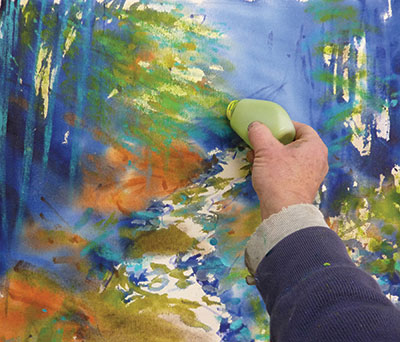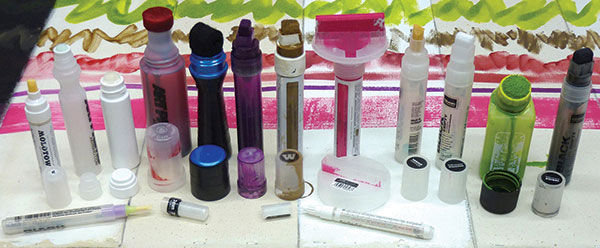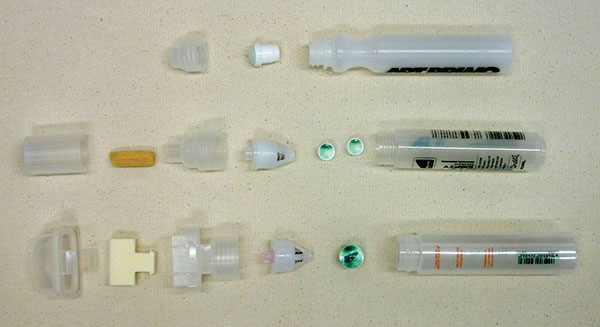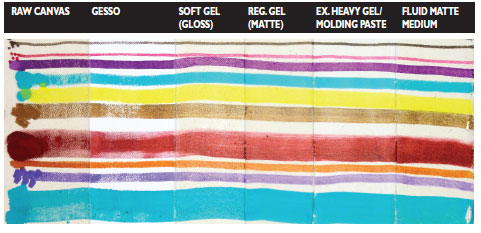
Drawing with pens and ink in artwork is not new. Artists have always combined drawing with painting, and the very act of painting itself incorporates drawing as line whenever one color or value is placed beside another, a thicker passage shows its edge against a thinner passage, or wet paint is scored by the end of a brush, palette knife or other tool. The use of drawing media such as pencils, charcoal, pastel or crayons of various sorts has often been used as part of the underpainting or as surface accents. It is common to see pencil lines showing through translucent passages in works by Matisse or Cézanne, and in watercolor paintings in general.
What is unique is the current range of different marking tools for artists. Some of this has been around for quite a while now, yet the proliferation of new drawing tools manufactured for artists has been exploding. Add to that the ingenuity of urban artists experimenting with their own designs. The options are enormous and continue to grow.
With the introduction of GOLDEN High Flow Acrylics, artists now have the ability to draw with a professional acrylic paint made in an ink-like consistency to work with all these new tools and more. GOLDEN High Flow Acrylic navigates easily from brush to refillable marker or from fountain pen to airbrush and more.
The unique feature of High Flow Acrylics is that artists can mix and blend them to make an infinite range of colors. The translucency of the color can also be adjusted by adding any amount of our Airbrush Transparent Extender while still maintaining the same liquid, flowing quality of the paint. Additionally, adding Titanium White to any color is a valuable tool in both increasing opacity and creating an infinite range of pastel tints. This means that artists have the ability to create an entire range of markers and drawing tools with their own custom colors that fit perfectly with their personal palette or precisely with the painting they are working on. The new addition of High Flow Acrylics to the GOLDEN line of products expands the capabilities of acrylic paints and the audience of artists who might not have considered acrylics before.
Markers and Pens in Fine Art
Artists have continued to search for a truly artist grade permanent marking tool. Many have become resigned to simply using office supply or craft type markers or pens in their work with the subsequent issues of bleeding or fading of the inks, or some kind of incompatibility with the other art materials they are using. With any mixed media work, the potential for mismatch of some sort increases greatly with the number of different brands and types of materials used. To reduce incompatibility issues and help increase the long term life of an artwork, it is always best to stay with quality brands, use only fine art grade materials whenever possible, and keep the number of different materials to a minimum. When in doubt, always test your materials first. (See our JP13 article, “Testing for Your Application.”)

“Permanent” Markers?
There is a plethora of pens and markers at the local office supply store but most are not made with fine art use in mind. Most pens and markers are not tested in the same way as fine art grade paints or other fine art grade materials. The term “permanent” is often used as part of the description with many markers and pens but this typically refers to the paint or ink’s ability to be water resistant or waterproof to some degree, and perhaps to its ability to adhere to certain surfaces, and does not necessarily refer to the lightfastness of the color.
GOLDEN High Flow Acrylics, used in these drawing and mark making tools, will enable a new level of fine art grade drawing potential with the widest range of color possibilities for use with acrylic painting and a variety of mixed media applications. With this system, the terms “Permanent”, “Lightfast” and “Fine Art Grade” can be applied with confidence, as the High Flow colors have the same durability and stable film qualities as all our other regular paint lines, along with compatibility in mixing and layering.
The Tools – Markers, Mops and Daubers
These are the common names of a large variety of refillable paint and ink drawing tools. All of these empty and refillable paint and ink drawing systems incorporate plastic containers with a tip or “nib.” The nibs on most high end markers are “spring loaded” so they can be pumped (pressing the tip to a surface repeatedly up and down) to prime them and they tend to be fairly stiff or hard and micro porous while the Mop and Dauber tips are soft with a very open porosity like a sponge or a piece of felt. The Mop and Dauber bodies are typically soft as squeezing them is often part of the delivery system. There are many different brands and types to choose from. My experience is limited to about 4 or 5 different brands, the most common being Molotow™ and Montana®. Check out your local art supply store to see what’s available or go online to check out the range of YouTube videos describing how to make your own mops. You’ll have plenty to choose from!
I have divided the discussion between “Markers” and “Mops and Daubers”, as these are different enough tools to warrant separate discussions.
Markers
What are typically called paint markers or paint pens are most often hard bodied, with harder, micro porous nibs that are replaceable. Some of the nibs can be inverted when they begin to wear out, and while others do not have the same chisel tip or shape on the opposite end, they can be inverted if desired. This type of drawing tool will tend to suit artists who need to make more controlled lines.
All of the markers that I tested were spring loaded. While most have mixingballs or barundums, some do not. If they don’t, we advise adding them, as this will help greatly in keeping the High Flow pigments thoroughly homogenized. You can use ball bearings, small marbles, or even stainless steel nuts and bolts, as long as they fit and move freely when shaken.

Mops and Daubers
These very simple liquid paint or ink drawing tools are usually more painterly in use than the pump tip paint markers. This means they can be messier, but also more desirable for painterly applications. They are often soft bodied with either sponge tips or synthetic sponge and fiber tips. They come with all sorts of names, including Paint Mops, NYC Mop™, Bingo Daubers, Sponge Daubers.
Some tips will have longer synthetic fiber “hairs” coming out of a domed spongy fibrous pad, and are often called “mohair tips” or “padded nibs”, while others have very short fuzzy hairs on a spongy fiber dome. I should point out that the term “nib” does not apply to mops and daubers, as a “nib” generally refers to a harder pen tip, such as the classical pointed metal tip of a quill pen. Sponge markers or paint daubers are commonly used in Bingo halls for quickly putting down a blot of color, and are called “Bingo Markers” or “Bingo Daubers”. All are very simple systems where the ink or liquid paint flows into the most often fairly wide porous tip and allows for a delivery where the flow is controlled via gravity, some capillary action in the tip, and pressure from lightly squeezing the container body. What is often called a NYC Mop, due to the invention by graffiti artists in New York City, is a larger and typically homemade variety that uses a fairly soft bodied container (think roll on deodorant) stuffed with a thick piece of felt or a folded piece of felt around a longer piece that acts as a wick. These are the most painterly types as they are larger, softer, squishier and the flow can be increased dramatically by squeezing the container. Graffiti artists prize these for how well you can get them to drip and splatter in use.
Drawing with these tools can be a joy for painters who like a more free flowing system, as the High Flow Acrylics will flow very nicely from this kind of large and very porous tip. If you are using one of the larger sponge or felt tops, then you can squeeze and move quickly and get some very painterly marks. Expect them to be messier and have some replacement tops on hand. Do not store these upside down as they tend to leak.
Guidelines for Using Refillable Markers, Mops and Daubers
- Never store larger markers, mops or daubers tip side down.
- You can store 2mm and 3mm paint markers tip side down.
- Be careful squeezing mops and daubers and always make sure the applicator tips are firmly secured. This is to avoid messy situations; use your imagination and some caution.
- While you can use our Fluorescent or Iridescent colors in most of these markers, mops and daubers, these pigments will not last as long without clogging. Fluorescents will last about a month before seeing some clogging and Iridescent colors will go for about a week before needing increased priming of the tip. Eventually, the tips will begin to trap too many of the larger mica pigments and the flow will decrease. If using these colors, make sure to have replacement nibs or tips on hand. Adding a few drops of Acrylic Flow Release mixed with water will greatly improve the flow of these larger pigment particle colors.
- Use on rough surfaces will degrade the tips faster, and the marks will have gaps or a more broken line quality.
- Use on smoother surfaces will allow for faster mark making with less broken line quality.
Substrate Surface

It is clear that there are some commonalities when using various grounds as drawing surfaces. Gesso, Fluid Matte Medium, Absorbent Ground, Acrylic Ground for Pastels, Light Molding Paste, a variety of Gloss Gels and Mediums, and raw canvas are just a few we’ve examined. As one would expect, the rougher surfaces such as Gesso on canvas, Absorbent Ground, and raw canvas caused drag and created broken lines whereas smooth surfaces, such as gloss mediums and gels or any other smooth painting ground or surface allowed for a slick and fast drawing ability. It is relatively easy to get the kind of line quality and “feel” that you want with these drawing tools by matching the marker, mop or dauber with the right painting ground. As with any new painting technique or material, testing and experimenting will be necessary to find the matches that work best.
There are certainly other paint application tools available that many of you may already be using that are not markers or mops, such as sponge rollers, fiber rollers, oversize brushes, paint pads, etc., that can make large scale drawing marks. There are other delivery systems such as pens and airbrush that can also be used with High Flow to create lines. Expressive calligraphy and brush painting in the Eastern tradition is possible with the High Flow Acrylics, allowing a wonderful density, sensitivity and flow off the brush. But not until now, has it been possible to create your own infinite array of colors for use in drawing tools that hold a consistent reservoir of acrylic paint. Although all these tools tend to make mark making easier by holding a consistent reservoir of paint, painting is about mark making and above all, these tools simply provide artists an ever expanding resource for realizing new marks and new discoveries.
About Scott Bennett
View all posts by Scott Bennett -->Subscribe
Subscribe to the newsletter today!
No related Post
